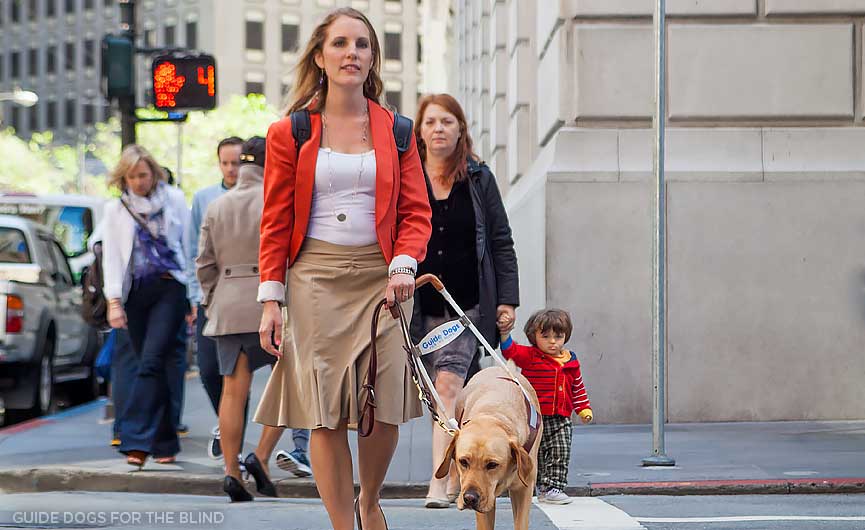On October 15th, we recognized “National White Cane Safety Day”. In honor of this day, I wrote an article about my first time using a white cane that was published in The Mighty, and I wanted to share it with our readers as well.
My First Time Using a White Cane to Navigate With Low Vision
My cane trainer and I had arranged to meet at a Starbucks in West Seattle, so my husband dropped me off on his way to work. I watched through the window as another car pulled into the space where his Prius had just been. A lady who looked to be about my age, in her mid 30s, stepped out wearing a cute professional-looking outfit with pretty long brown hair she had likely curled at the ends with hot rollers. She glided casually into the coffee shop to order her beverage, and I felt terribly envious of this stranger. While I sat waiting to meet my cane trainer due to my deteriorating peripheral vision, I imagined her on her way to some fabulous job looking perfectly put together, and driving her own car wherever she pleased.
Her carefree independence stood in stark contrast to my need for a tool that would help me to navigate. I glared inwardly, recalling the diagnosis of retinitis pigmentosa at a young age, a disease that slowly takes away peripheral vision leading ultimately to complete blindness. I pushed the angry thoughts away as I pictured my two young children waiting for me at home, needing an independent and confident mommy to care for them.
I decided to check my email on my phone to distract myself from my jealousy. As I scrolled through emails, I heard a tapping sound behind me. My trainer, Marci, said I would be able to recognize her right away because of her long cane that would be tapping along. I quickly jumped to my feet, turned toward the woman holding the long stick and said, “Marci?” The woman ignored me, and chatted with another woman about the busy morning. My eyes traveled down to the bottom of the stick, and I realized it was a broom. She was a Starbucks employee, taking a brief break from sweeping to chat with a customer. I quickly sat back down, hoping no one had seen or heard me asking for Marci.
The real Marci arrived with her tapping cane a few minutes later. I wasn’t sure if she would be completely blind, but I could immediately tell she had some vision from the way she made eye contact with me. She looked to be in her mid-50s with gray hair peeking out of her nice summer gardening hat, white pants, and a gray shirt. We sat and chatted until Marci suggested we move outside to continue our discussion and start the training. We stood up and made our way to the door. I had my cane out for the first time, and followed Marci out the door, not sure how to use this long white piece of aluminum in my hand.
Outside I felt thankful for the pleasant weather, and enjoyed getting to know Marci as we sipped our beverages. She showed me some cane basics, and I began to think this day would be better than I had anticipated. We decided to continue our training around the neighborhood, but needed to throw our garbage away before heading out. Marci led the way back into Starbucks to find a garbage can.
As soon as we entered, I could feel all the eyes on the two women with the long white canes. My ears perked up, keenly aware of every conversation we passed. “Really makes you thankful for what you have, doesn’t it?” I heard one woman remark as we reached the garbage can. There was no doubt in my mind that she was referring to Marci and me. Another woman was joyfully explaining the canes to her small child, “…and so now you know how people who can’t see can walk around by themselves” she was saying in the same tone that I had used dozens of times to explain difficult subjects to my daughter, trying to sound casual and cheerful. And as we walked out the door, I heard an older gentleman telling his friend about a blind woman he once knew. Our two minute trip to the garbage had sparked all sorts of conversations. I knew that was not a bad thing, but it didn’t feel good either. I felt completely exposed, and I wanted to hide.
As Marci and I made our way through a West Seattle park, I saw lots of moms about my age with strollers and toddlers that reminded me of my sweet little 2-year-old boy waiting for me at home. Some eyed us suspiciously while steering their children out of our path, while others offered a friendly “Hello, ladies! Beautiful day, isn’t it?” I wondered if the friendly ones would have been friendly if we didn’t have canes, or if the suspicious ones would have looked suspicious if we didn’t have canes. “I’m just like you!” I wanted to shout at them, “If I had my stroller here, pushing Benny along while he munched on Cheerios, you would not be able to tell I am different.”
I soon learned I had to pay less attention to what everyone around me was doing, and start focusing on the task at hand. Learning to walk with a cane took more concentration and coordination than I had envisioned. Right foot goes with left tap, left foot goes with right tap, side to side sweep, but not too high. Right foot, left tap, left foot, right tap, I repeated in my head and tried to stay focused.
“You’re moving your arm too much,” Marci coached me, “You really only need to move your wrist, and keep your arm out in front of the center of your body.” This felt like a lot for me to remember and it didn’t come as naturally as I had hoped it would. Marci was kind and encouraging towards me. She also had high expectations and knew instantly if I was not doing the techniques correctly.
“You’re still moving your arm too much.” she would correct me. “You need to move your arm to the center of your body,” she continued. “You’re tapping and stepping on the same side.” It reminded me of the one time my husband had tried to give me golf lessons, correcting every element of my form. “Keep your head still,” he would say so many times, and I was convinced I was keeping it still as he continued to correct me, to the point I finally shouted “I am!” at the top of my lungs, and we both agreed golf lessons weren’t the best activity for our marriage.
Likewise, I was certain I had it all down, and then I would hear Marci behind me, “You need to keep your arm still.” I was tempted to yell “I am!” a few times, but decided that was not the best way to thank a generous person who was donating her time to teach me. Instead, I offered to treat her to lunch to show my gratitude.
As we walked to the restaurant, side by side, canes in hand, it was like a magical “parting of the red sea.” I was elated not to have to dodge people and objects. Most people just quickly stepped out of our way, avoiding us and our canes and giving us lots of space. It was such a nice change from frantically trying not to bump into bodies that seemed to appear out of nowhere. But then I heard a loud voice.
“Ladies! Ladies!” a woman to our right was yelling in a commanding voice, “There’s a bunch of construction up here to your right, so you’re going to want to move to the left!” she announced importantly as she slightly pushed me toward Marci. “We’ve got it — thank you!” Marci replied. She had warned me about the special “helpers” who would think it’s OK to touch a complete stranger. Still, I felt so uncomfortable and frustrated by this. I could see the construction and the orange cones, and even if I couldn’t, my cane and ears would have alerted me to both. On the one hand, I knew the woman was just trying to be helpful. But on the other hand, I felt as though her helpfulness was telling me “You aren’t capable of navigating with your cane.”
I also knew part of my irritability was due to the fact that I really needed to eat some food, so I was delighted when we arrived at the sandwich shop for lunch. It was a casual sandwich cafe where you ordered up at the counter, seated yourself, and then collected your food when they called out your name. These type of restaurants often gave me anxiety because there was a lot to navigate in line, reading the menu from a distance, and then finding a table while carrying a tray full of food and grabbing your own beverage. So I was pleasantly surprised when we entered and an employee immediately came over to us, saying “If you’d like to find a table ladies, I’d be happy to go over the menu with you and bring you your food and drinks.” His helpfulness felt like actual help, and the way he spoke to us was not demeaning or belittling at all. He was making it clear that he knew we were capable of finding our own table, and yet he was trying to make the process of ordering and paying for our food less strenuous.
I was exhausted by the late afternoon. It reminded me of traveling overseas, and how tired I would feel at the end of each day after trying to converse in a foreign language. During these travels, I felt a strong sense of relief when I stepped into my hotel room and could turn “off” from focusing so hard on seemingly everyday tasks. I was looking forward to that familiar feeling of relief as I boarded the bus home.
My first time felt overwhelming, and exhausting. But I definitely wanted to try again. Each time I used my cane after that day, it got easier and more fluid. I soon found myself moving through life with newfound confidence and freedom.


